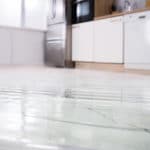If you have a GE dishwasher that is leaking from the bottom of the door, there are a few things that you can do to try and fix it.
In this article, we will walk you through some of the most common fixes for this issue. Hopefully one of these solutions will work for you.
Solution 1: Water Inlet Valve is Faulty
Water is drawn into the GE dishwasher through the water intake valve, which opens to allow water in. If the water intake valve is stuck open, the dishwasher will continue to fill with water until it leaks or overflows. Replace the water intake valve if it’s faulty. Water intake valves are not rebuildable—if one is bad, you must replace it.
Solution 2: Wash Arm is Damaged
A wash arm that is cracked may discharge a jet of water into the door seal, causing a leak. Examine the wash arm for flaws if it is damaged. Replace the wash arm if it is broken. Do not try to repair the crack with glue; the glue will deteriorate in the dishwasher. Make sure that the screws in the wash arm assembly are tight.
Solution 3: Dishwasher is Misaligned
Your dishwasher should be set up so that the front is parallel to the countertop and there are no obstructions in front of it. If your dishwasher isn’t functioning properly, it’s possible that it’s not level. This indicates that water may leak from the front door. Check to see whether your dishwasher is level horizontally and vertically.
Solution 4: Spray Arm is Stuck
If the spray arm is stuck or clogged, you’ll have a GE Dishwasher leaking issue. Check to see whether anything has fallen into your dishwasher’s bottom if this happens.
If nothing appears to be blocking it, apply a cotton swab with a vinegar and water solution for 45 seconds. If you have hard water, avoid using this technique.
Remove the lid and clean out each jet hole with a toothbrush, giving them an all-over cleaning within and outside of each one. It’s critical that no food particles remain near these regions since they might get caught and block future water flow from emerging from those jets.
Fill the jet region with four tablespoons of baking soda and two cups of vinegar.
Allow the solution to work its magic for about an hour before running your dishwasher again, or you may simply leave it overnight if that’s more convenient.
Solution 5: Pump Seal is Leaking
Look for leaks around the water pump while inspecting under the dishwasher. If you detect water leaking out of the rubber seal around the pump housing or motor, replace it with a new one. The pump seals may need to be replaced and/or tightened. When water flows over them, it builds up pressure, potentially causing leakage at any point in your dishwasher.
A leak near the pump is the easiest approach to tell if a dishwasher is leaking. This problem occurs frequently owing to a loose seal, but you won’t notice any signs of leakage until your machine has been in use for an extended period of time.
Solution 6: Door Gasket is Faulty
Look for tears, gaps, or cuts in the gasket that might cause a dishwasher door leak. Close the dishwasher door completely around the edge to see if the door gasket is making good contact. If nothing sticks to a dollar bill all the way around the door, there is likely a gap in the gasket. Check any gaps or tears in the door gasket and replace it if necessary.
Solution 7: Drain Pump is Leaking
The drain pump may be faulty in some cases, causing a leak. In certain situations, if the drain does not completely empty the water, you might get an overflow. If the pump begins to drip fluid from its axle, it should be replaced.
Solution 8: Float Switch is Faulty
To prevent the machine from overfilling with water, some GE dishwashers employ a float and switch.
The float is positioned near the bottom of the machine and activates when enough water has gathered in it or perhaps been contaminated by tiny objects being drawn into it. If this occurs, it closes an electrical circuit that cuts off the incoming water flow.
A dishwasher won’t leak unless the float or float switch is faulty, and the water level in the basin is too high. The correct level of water in your dishwasher should be between the heating element at the bottom and the top fill line. If you discover that there is too much water in your dishwasher, it might be due to a faulty float switch.
Test the float switch for continuity with a multimeter. If there is no continuity, replace the switch.
Conclusion
A dishwasher leaking from the bottom of the door can be a complicated issue to fix. It could stem from any number of different problems, but it’s essential that you address these issues before water damage or mold sets in and causes more costly repairs.
The 8 solutions we’ve provided are among the most common for GE dishwashers, so even if your machine doesn’t fit into any of these categories, you can still troubleshoot it using one of these methods. If all else fails, feel free to call a technician for help.
Now that you know how to fix the GE dishwasher leaking from the bottom of the door, you can rest assured that your machine won’t cause any more water damage in your home. Be sure to check the gaskets, seals, and float switch regularly to avoid any future leaks. Thanks for reading!
Do you have any tips on how to fix the GE dishwasher leaking from the bottom of the door? Let us know in the comments below!






